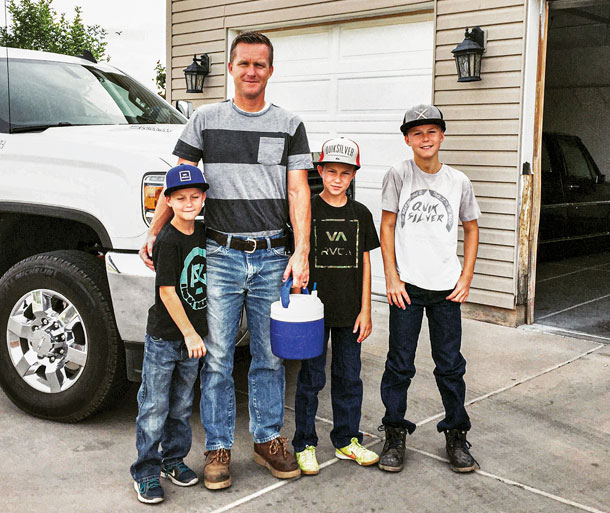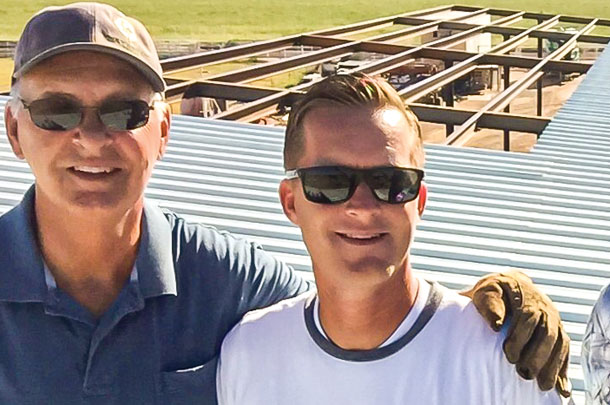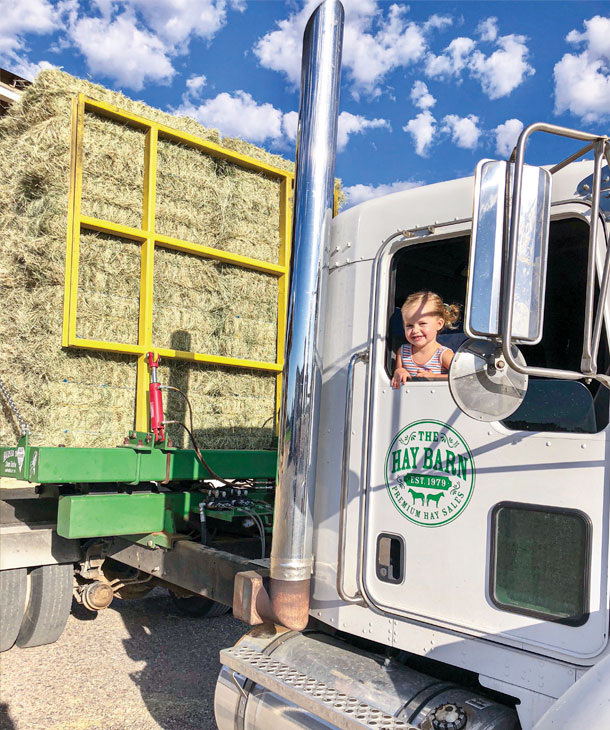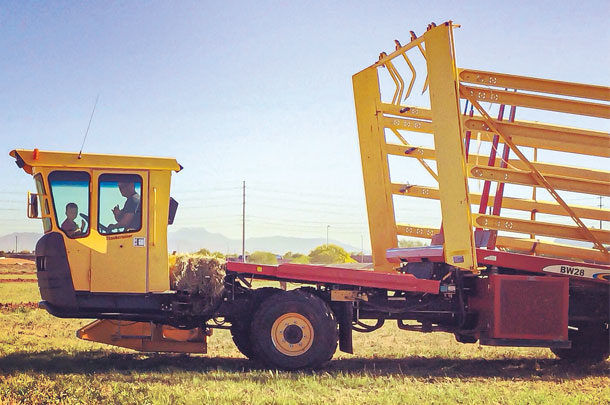But in the ’80s, cotton prices were becoming more volatile due to a flooded international market, and the LeSueurs experimented with a greener crop: alfalfa.
Nate LeSueur is a fifth-generation farmer in Gilbert, Arizona, about a half-hour southeast of Phoenix. He was just a boy when his dad saw the changing tides of the cotton industry.
“My dad started taking cotton fields out of production and putting alfalfa into production,” he says. “That gave my brothers and me jobs.”

Now in his early 40s, LeSueur has been farming on his own for 15 years.
“I lease farm ground from my dad and other landowners,” he says. “I have about 900 acres of alfalfa in production, and 900 acres of bermudagrass in production.”
Depending on the weather, the LeSueurs take seven to eight hay cuttings a year. They’re harvesting continually from March to November on 30-day harvest cycles.
“We cut about 150 acres a day,” LeSueur says, which gets them through the entire farm in about 25 days. There are people continually cutting, baling and irrigating during the entire growing season. Between the retail and farming sides of the business, LeSueur has 23 employees on payroll.
All that greenery is destined for one market: horses.

“My dad has always been a big horseman,” LeSueur says, adding that the Phoenix suburbs have become a mecca for horsemen and women of all stripes.
LeSueur explains that horse owners are generally looking for a different kind of hay than cattle buyers. While cattle hay buyers want a high protein content in their alfalfa, horse alfalfa is harvested a little later, almost to bloom. Bermudagrass is a complementary feed to alfalfa, and it’s also sufficient on its own for horses that aren’t being worked very hard.
After the initial transition from cotton to hay, the LeSueurs were selling their entire crop to hay brokers. But Nate thought they could do better.
“When I was in college, I began pushing retail. I was partners with my dad, and we were still bulk-selling our hay,” he says. “But the retail hay market is a lot more steady.”
When Nate started experimenting with direct sales, it only took four years before he was selling more hay than he could grow, and Nate became a hay broker himself.
“I will buy from local farmers direct, or some local brokers,” LeSueur says. “I do try to buy locally. That means there’s less hay for me to compete with.”
He deals exclusively in three-string small bales, 100 pounds a pop.
The retail side of the business has exploded: LeSueur’s cellphone number is painted on 10 trucks, you can hear ads for The Hay Barn on local radio stations and he operates two retail outlets where customers can buy hay by the bale.
“The two retail outlets are about 15 miles apart. I have teenage boys at both locations,” LeSueur explains. Two of LeSueur’s five kids already work for him in the family business. “Customers can arrive, and we’ll load their pickup truck with as many bales as they want. We move about 2,000 bales a week that way, and over half of those customers are women.”
Early on, when LeSueur was building his retail hay empire, he zeroed in on a single strategic investment he knew would tip the scales in his favor.
“I invested in building hay barns on our farms,” he says. “I can store 7,000 tons of hay in the off-season. That way, my customers don’t leave me in the winter. It’s what gives me an advantage over other farmers.”
LeSueur’s other investments have mostly been in equipment that lets him transport hay and deliver it to customers: semi-trucks and hay squeezes that let him stack and load quickly.

He has a fleet of small trucks that deliver bales by hand to people’s homes, as well as semi-trucks that can deliver a 512-bale load anywhere within a 200-mile radius. LeSueur is also the hay supplier for a handful of feed stores farther afield from the Phoenix area.
LeSueur struggles with the same challenges as other hay growers – chiefly weather and getting hay harvested in a manner that holds its value. But there are other challenges unique to his business.
Urban sprawl tops the list. The U.S. Census Bureau pegs Phoenix as the fastest growing city in the entire country.
“The southeast valley of Phoenix is growing so rapidly, so a lot of the horses are moving farther out,” he explains. “I’ve been trying to follow the horses with my retail outlets.”
Apart from looking for retail locations closer to where the horses are, LeSueur has explored other means of growing his business – some without success.
“I dabbled in buying and reselling bagged feed,” he says, but there was too much added headache in dealing with damaged product so LeSueur has decided to stick to hay exclusively, for now.
“One massive investment I’ve been looking at is buying a pelletizer so I can bag my own feed,” LeSueur says. “It seems that about half of horse owners feed baled feed, and the other half feed bagged feed,” he says, with many feeding both.
Right now, LeSueur says he’s not selling anything in the bagged feed market, and he wonders if there’s an opportunity there.
Arizona is one of several agricultural states in the Southwest that has seen an influx of international land buyers. Middle Eastern companies from countries like Saudi Arabia and the United Arab Emirates have increasingly sought water-rich farmland to produce the alfalfa needed to sustain cow herds in water-poor countries half-way across the world.
LeSueur says the change hasn’t affected him at all. He acknowledges it as a reality of doing business in a free-market economy.
“I’m totally fine with a free market and people buying farms and growing their own hay,” he says.
LeSueur guesses the influx of international farming operations has possibly even benefited him by pulling hay out of the local market – a boon to anyone selling their own Arizona hay locally.
When he takes the 30,000-foot view of his life and business, LeSueur feels good about where he is.
“Some of the hard things about farming are that I don’t have a 401k or retirement or benefits that you might get working for a company. That causes some stress,” LeSueur says. But getting to create those things for himself is working out, and LeSueur says the perks of being a self-made hay entrepreneur outweigh the challenges.
“I love being outdoors, I love being my own boss,” he says. “I love that I can work with my kids side by side and teach them how to work.”
If LeSueur had any advice to impart to hay producers contemplating direct sales, it’d be that the customer is always right. A cliche? Perhaps. But it’s worked for The Hay Barn. Although there are some obnoxious customers, LeSueur says almost everyone he does business with is just out for good hay.
“Obviously hay is not made in a factory,” he says. “Sometimes there are weeds in bales or other problems.”
“I was taught by my dad to replace or refund any hay people aren’t happy with. I’ve continued to do that. It’s hard to do, but I have customers that have been buying hay from me for 20 years.”
Losing a sale in the short term doesn’t outweigh the profit of earning a long-term customer, LeSueur says. ![]()
PHOTO 1: Arizona family sells hay straight from the field to the horse’s mouth.
PHOTO 2 - 4: Nate LeSueur’s kids are sixth-generation Arizona farmers. They work for the family business, The Hay Barn, delivering hay the family grows to horse owners in the greater Phoenix area. In addition to sales by the bale, The Hay Barn also delivers in large quantities within a 200-mile radius of its headquarters in Gilbert, Arizona. Photos courtesy of The Hay Barn.
Monica Gokey is a freelance writer and livestock producer based in Idaho.











